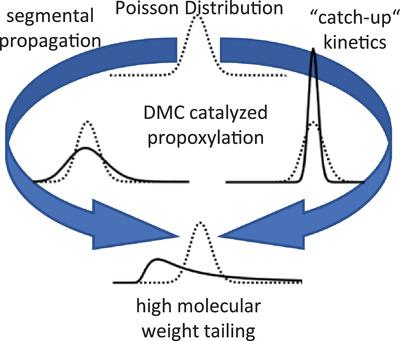当前位置:
X-MOL 学术
›
Macromol. Theor. Simul.
›
论文详情
Our official English website, www.x-mol.net, welcomes your
feedback! (Note: you will need to create a separate account there.)
Molecular Weight Distribution in Di Metal Cyanide Catalyzed Polymerization 2: Numerical Simulation of Chain Activation/Deactivation and Diffusion Effects
Macromolecular Theory and Simulations ( IF 1.8 ) Pub Date : 2021-08-18 , DOI: 10.1002/mats.202100013 Marcel Klinger 1 , Rolf Bachmann 2 , Andreas Jupke 1
Macromolecular Theory and Simulations ( IF 1.8 ) Pub Date : 2021-08-18 , DOI: 10.1002/mats.202100013 Marcel Klinger 1 , Rolf Bachmann 2 , Andreas Jupke 1
Affiliation

|
A kinetic model for the dynamic simulation of Di Metal Cyanide (DMC) catalyzed alkoxylation is proposed. The model covers the characteristic “catch-up” kinetics, favoring the growth of small polymers, and high molecular weight tailing (HMWT), which broadens the distribution toward large polymers. Computations are based on the direct numerical integration of fundamental reaction kinetics of a living polymerization with chain length dependent reaction coefficients. It is observed that “catch-up” kinetics can be modeled by molecular weight (MW) dependent propagation and activation constants. The formation of HMWT can be described by MW dependent segmental growth. Thereby, the segmental growth is influenced by chain length dependent deactivation constants and effects of polymer diffusion. Simulations of (semi-)batch operations return an appropriate reproduction of measured polymer distributions. Processes with continuous addition of starters (CAOS) and single stage continuous (CSTR) processes are compared to (semi-)batch operations. Kinetics without “catch-up” mechanism have a strongly broadened MWD in CAOS/CSTR processes, compared to (semi-)batch operations. Also, the concentration of short chained polymers, which act as catalyst poison, is increased. In contrast, CAOS/CSTR simulations with “catch-up” mechanism result in a MWD comparable to results from (semi-)batch operations and there is no accumulation of short chained polymers.
中文翻译:

二金属氰化物催化聚合中的分子量分布 2:链活化/失活和扩散效应的数值模拟
提出了用于动态模拟二金属氰化物 (DMC) 催化烷氧基化的动力学模型。该模型涵盖了典型的“追赶”动力学,有利于小聚合物的生长,以及高分子量拖尾 (HMWT),这将分布扩大到大聚合物。计算基于活性聚合的基本反应动力学与链长相关反应系数的直接数值积分。据观察,“追赶”动力学可以通过依赖于分子量 (MW) 的传播和活化常数来建模。HMWT 的形成可以通过 MW 依赖的节段生长来描述。因此,链段增长受链长依赖的失活常数和聚合物扩散的影响。(半)分批操作的模拟返回测量的聚合物分布的适当再现。将具有连续添加起始剂 (CAOS) 和单级连续 (CSTR) 工艺的工艺与(半)分批操作进行比较。与(半)批量操作相比,没有“追赶”机制的动力学在 CAOS/CSTR 工艺中具有显着扩大的 MWD。此外,作为催化剂毒物的短链聚合物的浓度增加。相比之下,具有“追赶”机制的 CAOS/CSTR 模拟产生的 MWD 与(半)批量操作的结果相当,并且没有短链聚合物的积累。与(半)批量操作相比,没有“追赶”机制的动力学在 CAOS/CSTR 工艺中具有显着扩大的 MWD。此外,作为催化剂毒物的短链聚合物的浓度增加。相比之下,具有“追赶”机制的 CAOS/CSTR 模拟产生的 MWD 与(半)批量操作的结果相当,并且没有短链聚合物的积累。与(半)批量操作相比,没有“追赶”机制的动力学在 CAOS/CSTR 工艺中具有显着扩大的 MWD。此外,作为催化剂毒物的短链聚合物的浓度增加。相比之下,具有“追赶”机制的 CAOS/CSTR 模拟产生的 MWD 与(半)批量操作的结果相当,并且没有短链聚合物的积累。
更新日期:2021-09-19
中文翻译:

二金属氰化物催化聚合中的分子量分布 2:链活化/失活和扩散效应的数值模拟
提出了用于动态模拟二金属氰化物 (DMC) 催化烷氧基化的动力学模型。该模型涵盖了典型的“追赶”动力学,有利于小聚合物的生长,以及高分子量拖尾 (HMWT),这将分布扩大到大聚合物。计算基于活性聚合的基本反应动力学与链长相关反应系数的直接数值积分。据观察,“追赶”动力学可以通过依赖于分子量 (MW) 的传播和活化常数来建模。HMWT 的形成可以通过 MW 依赖的节段生长来描述。因此,链段增长受链长依赖的失活常数和聚合物扩散的影响。(半)分批操作的模拟返回测量的聚合物分布的适当再现。将具有连续添加起始剂 (CAOS) 和单级连续 (CSTR) 工艺的工艺与(半)分批操作进行比较。与(半)批量操作相比,没有“追赶”机制的动力学在 CAOS/CSTR 工艺中具有显着扩大的 MWD。此外,作为催化剂毒物的短链聚合物的浓度增加。相比之下,具有“追赶”机制的 CAOS/CSTR 模拟产生的 MWD 与(半)批量操作的结果相当,并且没有短链聚合物的积累。与(半)批量操作相比,没有“追赶”机制的动力学在 CAOS/CSTR 工艺中具有显着扩大的 MWD。此外,作为催化剂毒物的短链聚合物的浓度增加。相比之下,具有“追赶”机制的 CAOS/CSTR 模拟产生的 MWD 与(半)批量操作的结果相当,并且没有短链聚合物的积累。与(半)批量操作相比,没有“追赶”机制的动力学在 CAOS/CSTR 工艺中具有显着扩大的 MWD。此外,作为催化剂毒物的短链聚合物的浓度增加。相比之下,具有“追赶”机制的 CAOS/CSTR 模拟产生的 MWD 与(半)批量操作的结果相当,并且没有短链聚合物的积累。











































 京公网安备 11010802027423号
京公网安备 11010802027423号